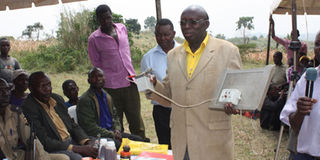Bee venom: Earn while conserving forests

Katenta Apuuli (in coat) displays a bee venom collector to communities around Matiri forest reserve in Kyenjojo District. PHOTO BY FELIX BASIIME
What you need to know:
- Bagonza says they already have the technology and the Korean government offered 50 per cent of their technology up to producing of injectable drugs, creams and even capsules. “We have the capacity of reaching there. But even without that, we can export the at a very good price to Korea although it costs more in the European market. However, it is not easy to get certification” Bagonza says.
- The association wants government to allow the members to set up thousands of bee hives in Matiri forest reserve [in Kyenjojo District] for commercial bee keeping.
Collecting bee venom, a highly demanded hive product can enable communities earn while conserving forests, writes
Adolf Bagonza started in a simple way as a beekeeper in Kabarole District 30 years ago, but eventually went for further training. He is now a trainer and researcher, who has found a way to conserve forests better while earning more. He connects beekeeping and conservation for commercial and health ventures.
Through his experience, he has found that when forests are gone, there will be no more apiaries.
The rate of deforestation in Kyenjojo and Kibaale districts is very high despite government efforts through various stakeholders including National Forest Authority (NFA).
“The moment these forests are gone there would be no more bees” observes Bagonza, the chairman Kabarole Beekeepers’ Association.
He says a way to end deforestation is for the locals to engage in beekeeping in the forest reserves so that they can gain financially and do away with cutting the forests.
“I would engage the beekeepers in these forests as I collect the bee venom and for them they gain in selling the honey,” he says.
“Rwenzori region has the best honey in the world, organic honey” observes Katenta Apuuli, a former ambassador, and now a member of the association.
It also carries a research in curing several diseases by using the bee venom.
The research
“I work with seven doctors who saw that bee venom can handle viral infections, cancer, flue, coughs, fibroids and others, It has worked on athritis and other many other complicated diseases,” he says. “It is now five years and we have been trying it and seen it can work”.
He says they lack a machine called a bee venom purifier. “If we could purify the bee venom, then we could have it in a clear form, which could be dissolved in clean water to make an injectable drug”.
Bagonza says they already have the technology and the Korean government offered 50 per cent of their technology up to producing of injectable drugs, creams and even capsules. “We have the capacity of reaching there. But even without that, we can export the at a very good price to Korea although it costs more in the European market. However, it is not easy to get certification” Bagonza says.
The association wants government to allow the members to set up thousands of bee hives in Matiri forest reserve [in Kyenjojo District] for commercial bee keeping.
He adds, “We want to do commercial bee keeping where every beekeeper can set hundreds of bee hives and harvest kilogrammes of bee venom, hundreds of kilograms of honey, pollen, propolis and others and get millions every year and improve our livelihoods.”
Currently, there are five members are involved in bee venom production and they are able to collect 100 gms of bee venom every month.
Challenges
The association identifies two main challenges: An area to set beehives and work on them without disturbance. “Because when we set machines, bees become aroused and they can attack livestock and people,” Bagonza explains.
The other is capital to buy equipment that they may not afford. This includes bee venom purifier and the harvesting machines. “We want very many; if we can have the purifier and other machines then we can be able to produce enough venom for export market,” he says.
Bee extractor is Shs3m while the bee venom purifier is Shs150m.
They also want government to come in and do more research and scientific back up.
Eventually, under a Memorandum of Understanding, National Forest Authority allowed the beekeepers’ association to carry out activities in Matiri forest by mobilising the neighburing communities in their programmes.
The product
Since the mid-1950s, the electric shock method has been used to stimulate the bees to sting. The collector frame is usually placed at the entrance of the hive and connected to a device which supplies electrical impulses.
The collector frame is made from wood or plastic and holds a wire grid. Underneath the wires is a glass sheet which can be covered with a plastic or rubber material to avoid contamination of the venom. During collection, bees come in contact with the wire grid and receive a mild electric shock.
They sting the surface of the collector sheet as they see this to be the source of danger.
The venom is then deposited between the glass and the protective material where it dries and is later scraped off.
Honey bee venom is a colourless liquid. After drying, it is a white powder-like material if protected from oxidation. If it is not protected, oxidation will change the colour from white to brownish-yellow. Changes caused by oxidation of certain components of the venom may decrease its healing effect.
There are different kinds of venom such as: pure whole dried, whole dried and freeze-dried (lyophilised) bee venom. Pure whole dried bee venom is the purest venom. It is white in colour (often it is snow white), not contaminated with foreign materials and colourless when it is used in a solution.
If bee venom is protected from moisture and light it can be stored for five years or more.
Source: ibiblio.org




